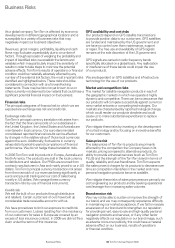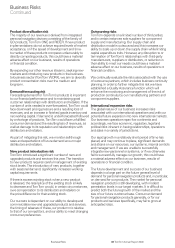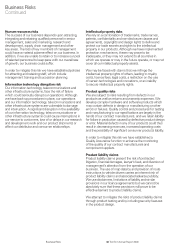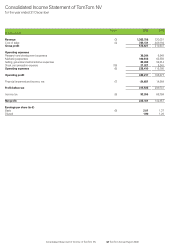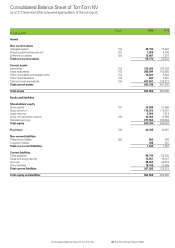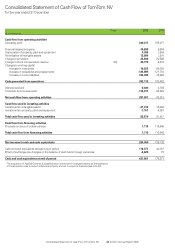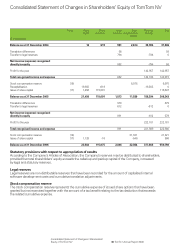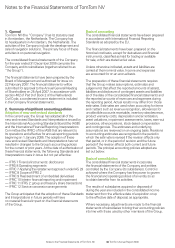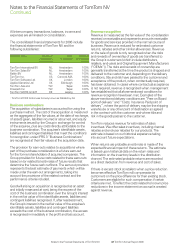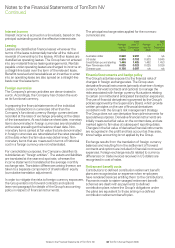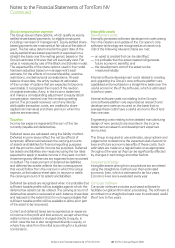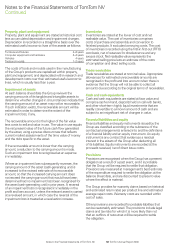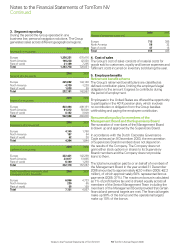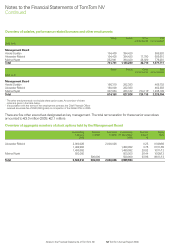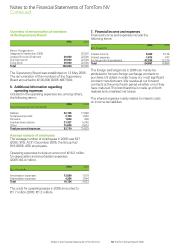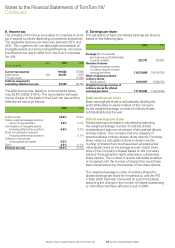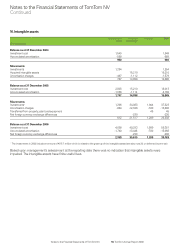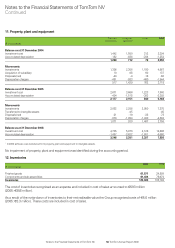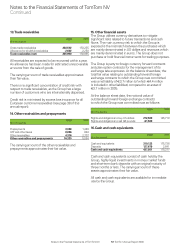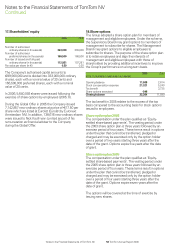TomTom 2006 Annual Report Download - page 50
Download and view the complete annual report
Please find page 50 of the 2006 TomTom annual report below. You can navigate through the pages in the report by either clicking on the pages listed below, or by using the keyword search tool below to find specific information within the annual report.
48 TomTom Annual Report 2006Notes to the Financial Statements of TomTom NV
Interest income
Interest income is accrued on a time basis, based on the
principal outstanding and at the effective interest rate.
Leasing
Leases are classified as finance leases whenever the
terms of the lease substantially transfer all the risks and
rewards of ownership to the lessee. All other leases are
classified as operating leases. The Group has not entered
into any material finance leasing arrangements. Rentals
payable under operating leases are charged to income on
a straight-line basis over the term of the relevant lease.
Benefits received and receivable as an incentive to enter
into an operating lease are also spread on a straight-line
basis over the lease term.
Foreign currencies
The Company’s primary activities are denominated in
euros. Accordingly, the Company has chosen the euro
as its functional currency.
In preparing the financial statements of the individual
entities, transactions in currencies other than the
Company’s functional currency (foreign currencies) are
recorded at the rates of exchange prevailing at the dates
of the transactions. At each balance sheet date, monetary
items denominated in foreign currencies are retranslated
at the rates prevailing at the balance sheet date. Non-
monetary items carried at fair value that are denominated
in foreign currencies are retranslated at the rates prevailing
at the date when the fair value was determined. Non-
monetary items that are measured in terms of historical
cost in a foreign currency are not retranslated.
For consolidation purposes, the Company classifies its
subsidiaries as “foreign entities”. The assets and liabilities
are translated at the year end spot rate, whereas the
income statement is translated at the average monthly
exchange rate. Translation differences arising thereon are
taken to a separate component of shareholders’ equity
(cumulative translation adjustment).
In order to mitigate the risks to foreign currency exposures,
the Group enters into forward contracts and options
(see next paragraph for details of the Group’s accounting
policy in respect of financial instruments).
The principal exchange rates applied for the non-euro
currencies are:
Rate Rate
Average as at 31 Average as at 31
rate for December rate for December
2006 2006 2005 2005
Australian dollar 0.600 0.597 n/a n/a
US dollar 0.800 0.758 0.803 0.845
Great Britain pound sterling 1.446 1.485 1.462 1.453
New Taiwanese dollar 0.025 0.023 0.025 0.026
Chinese yuan 0.106 0.097 n/a n/a
Financial instruments and hedge policy
The Group’s activities expose it to the financial risks of
changes in foreign exchange rates. The Group uses
derivative financial instruments (primarily short-term foreign
currency forward contracts and options) to manage the
risks associated with foreign currency fluctuations relating
to certain committed and anticipated transaction exposures.
The use of financial derivatives is governed by the Group’s
policies approved by the Supervisory Board, which provide
written principles on the use of financial derivatives
consistent with the Group’s risk management strategy.
The Group does not use derivative financial instruments for
speculative purposes. Derivative financial instruments are
initially measured at fair value on the contract date, and are
marked again to fair value at subsequent reporting dates.
Changes in the fair value of derivative financial instruments
are recognised in the profit and loss account as they arise,
since hedge accounting is not applied by the Group.
Exchange results from the translation of foreign currency
balances and resulting from the settlement of forward
contracts and options are included in financial income and
expenses. Foreign exchange results related to currency
differences on trade invoices received in US dollars are
recognised in cost of sales.
Retirement benefit costs
Contributions to defined contribution retirement benefit
plans are recognised as an expense when employees
have rendered services entitling them to the contributions.
Payments made to state-managed retirement benefit
schemes are dealt with as payments to defined
contribution plans where the Group’s obligations under
the plans are equivalent to those arising in a defined
contribution retirement benefit plan.
Notes to the Financial Statements of TomTom NV
Continued


